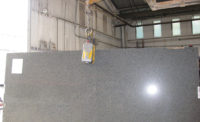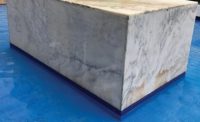There was a story on the news a while back about some guy taking a baseball bat to Our Lady of Lourdes Cathedral in downtown Spokane, WA. The perpetrator singled out a 100-year-old Italian bas-relief carving of the Last Supper, making the historic work of marble his personal piñata. After shaking my head, and wondering just what is wrong with people, I told my wife, “I should go down there and see if I can help fix the damage.”
I had the best intentions, but I never could find the time to go check it out. It wasn’t until about a week later that my father came out to the shop saying, “I went out to that vandalized church to help them out.” He had beaten me to it. Although the church offered to pay for the simple restoration, my dad told them not to bother because it ended up being minor damage that was easy to repair.
While he was fixing the sculpture, the priest inquired about a few projects that they were considering to enhance the outdated look of the church. Sorry, but nothing screams 1980 like teal blue carpet. Dad said, “I’ll introduce you to my son, this is right up his alley.”
The first project consisted of adding a book holder to the existing historic pulpit, without it looking like an afterthought. Father Connall, the residing rector of the church, was very specific about certain aspects of the addition. So much that I felt it necessary to make a wooden mock-up of the proposed new piece. I offered a version with carved acanthus leaves that I thought was perfect, but the Catholic design criteria these days calls for a simpler elegance. The final design mimics some of the existing moldings, but with a rolled scroll design as the book holder.
I installed the addition the day before the funeral of my dear Italian teacher, Tullia Barbanti. She would have enjoyed hearing about this project in her beloved church that was so central to her life. Sitting at the funeral, I couldn’t help but remember the tiny rose bud that my father secretly carved into St. Aloysius’ altar that we made more than 20 years ago in honor of his mother, and remembering thinking how grandma would of been proud that her son and grandson created the centerpiece of such a beautiful church.
St. Aloysius altar circa 1995. Not bad for a couple of newbies with hand tools.
With that project complete, I began the design of a new altar that the church wanted to consider. The application required serious thought about weight, as it would be on a raised platform as opposed to the specially poured concrete foundation that Vincent DeFelice and I collaborated on a few years ago for St. Thomas More’s five-ton altar. This design was approached more from a stone fabricator’s point of view, utilizing slab material mitered and laminated to give the illusion of mass while reducing the weight by nearly two-thirds.
The one thing that instantly grabs your attention in the cathedral are the exquisite stained-glass windows, the colors of which rival anything I’ve seen in Europe. It was this beautiful display of vivid color that drove the design of the new altar. The jewel-like blue tones of Azul Bahia granite added just the right amount of accent to be effective, and Father Connell appreciated the blue color correlation with the Blessed Virgin Mary.
And so production began. The Bishop’s chair platform soon followed, as a companion piece to the altar, along with new elevated bases for the existing statues of Jesus and Mary completing the ensemble. On Mary’s platform, I set the Carrara marble veining in a “V” pattern, representing the chalice, or femininity. The devil is in the details, even though that’s not the best analogy for this subject.
The last phase was a series of radius stairs leading to the altar made of 22 slabs worth of Carrara marble, with the middle landing section being as large as the slabs would allow, about a half ton each in this case. The finished edges on these pieces is a steep radius bevel, which will create a beautiful transition to the carpet when complete.
On behalf of the entire Mario & Son team, we are forever thankful to Father Connall and all that made this project a reality.
This story was taken from Marcella’s blog, “Playing with Rocks,” which can be found at: http://www.marioandson.com/blog/.













